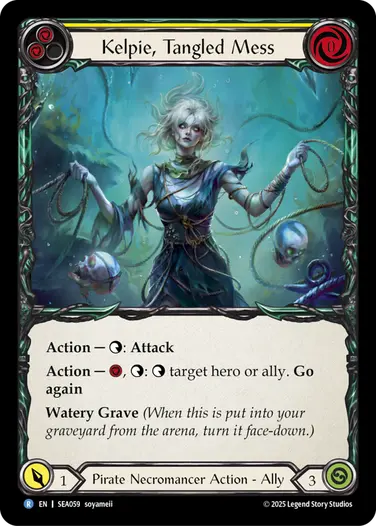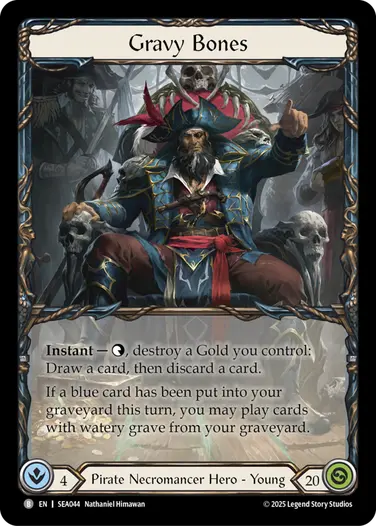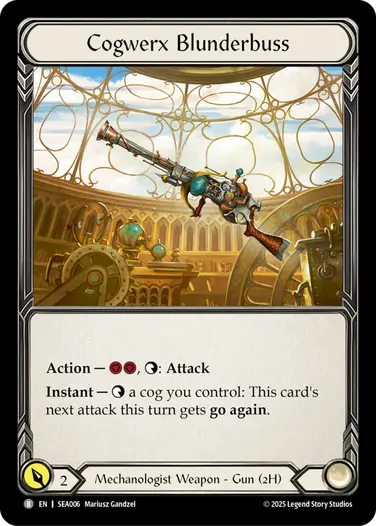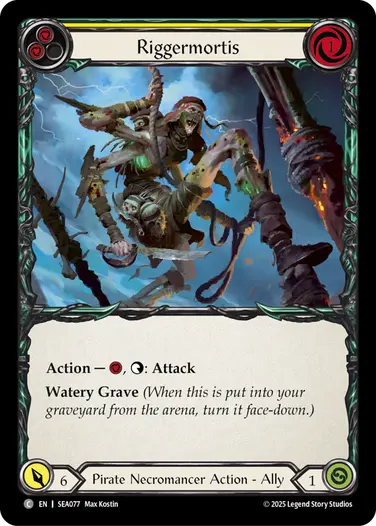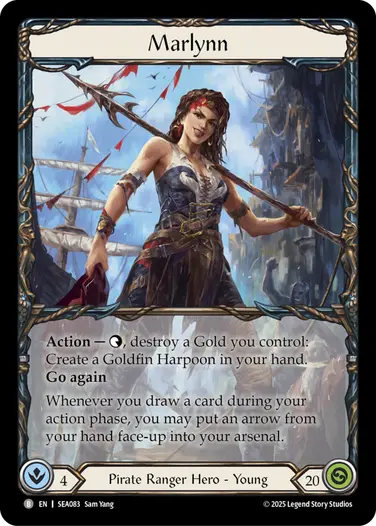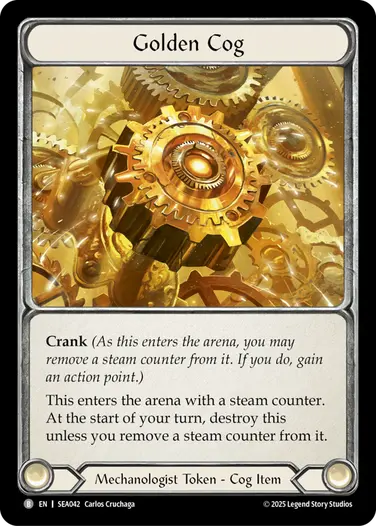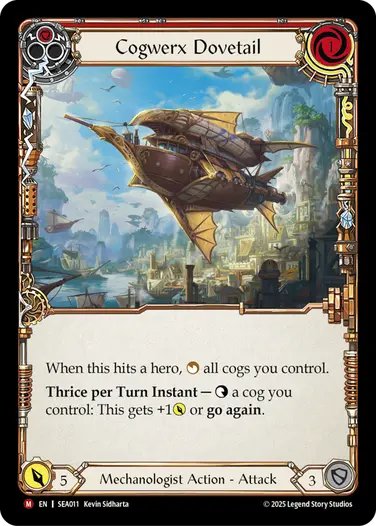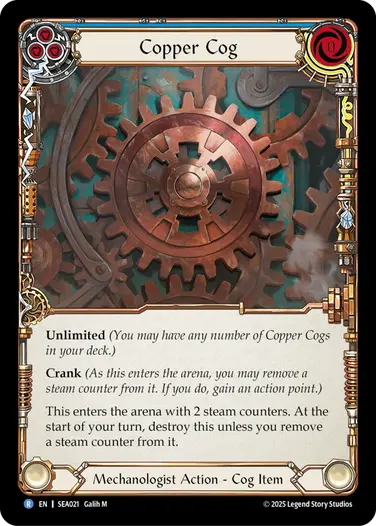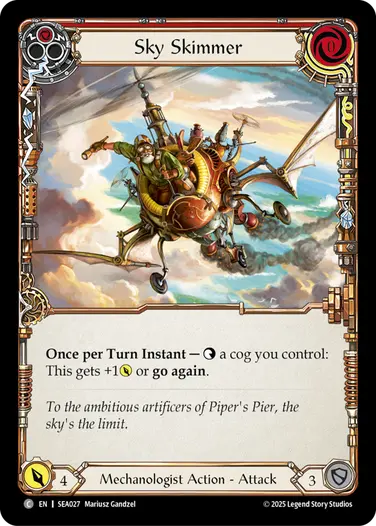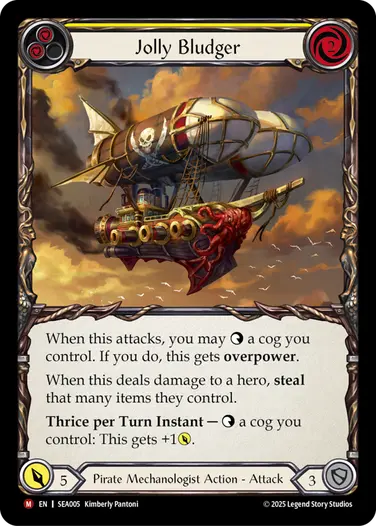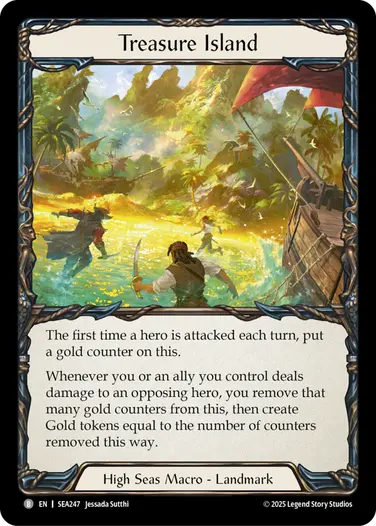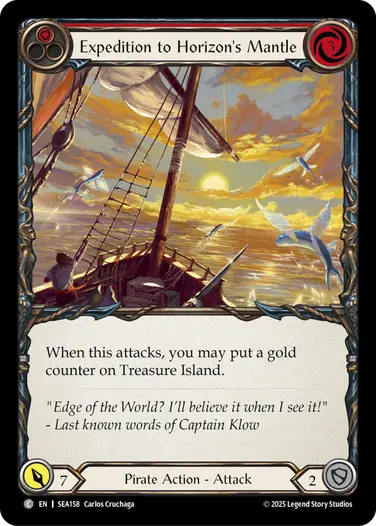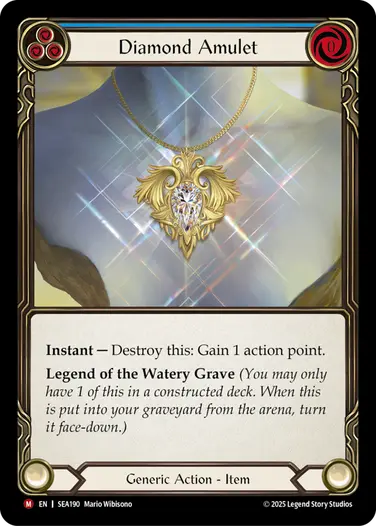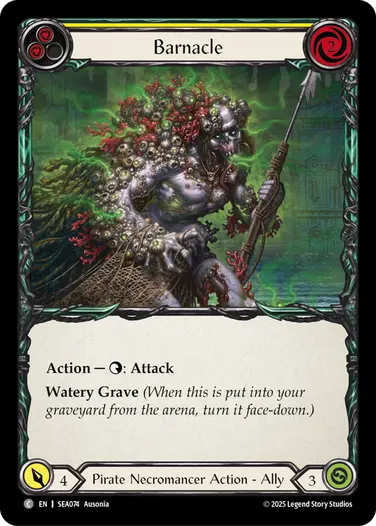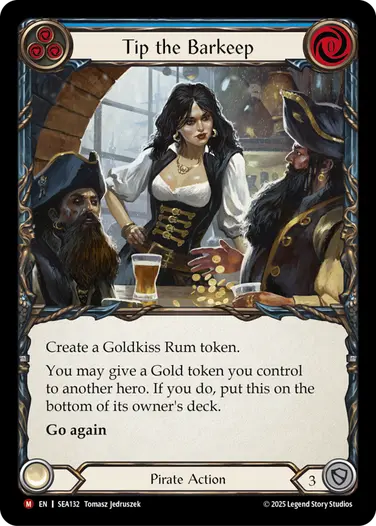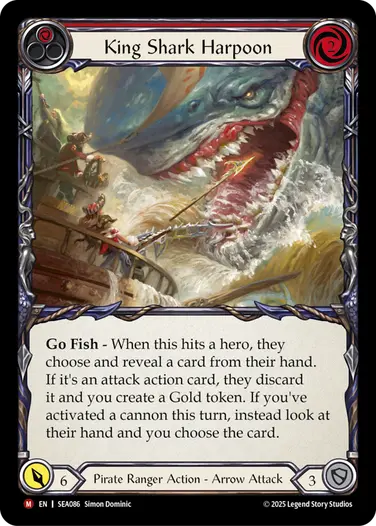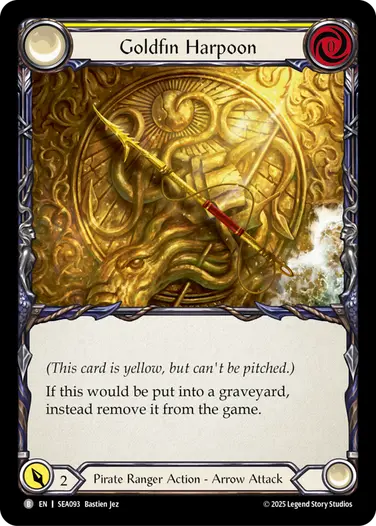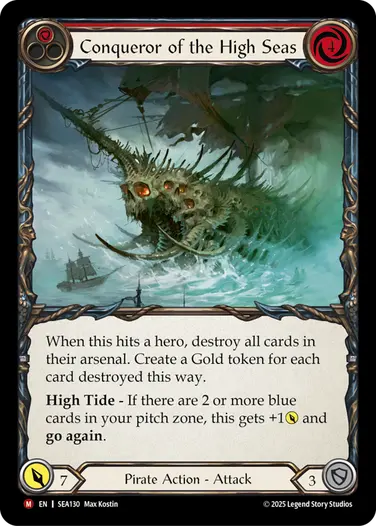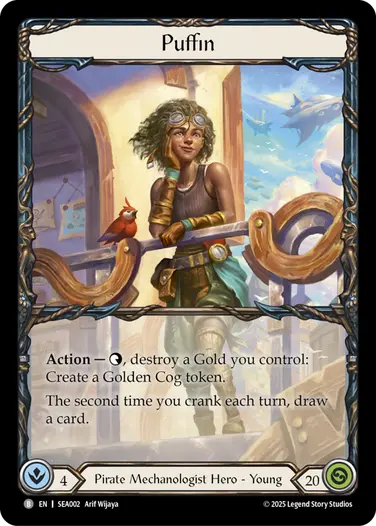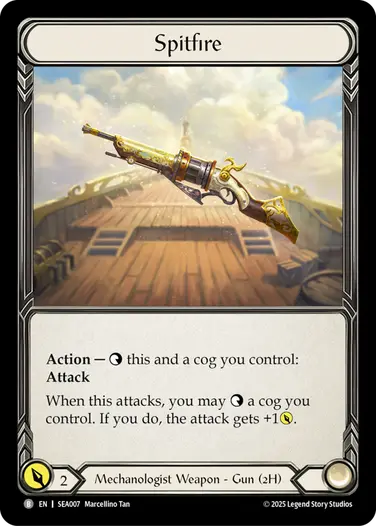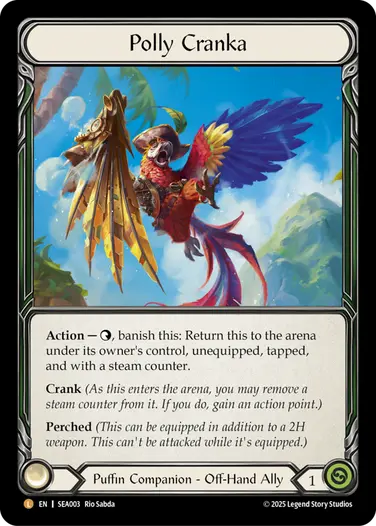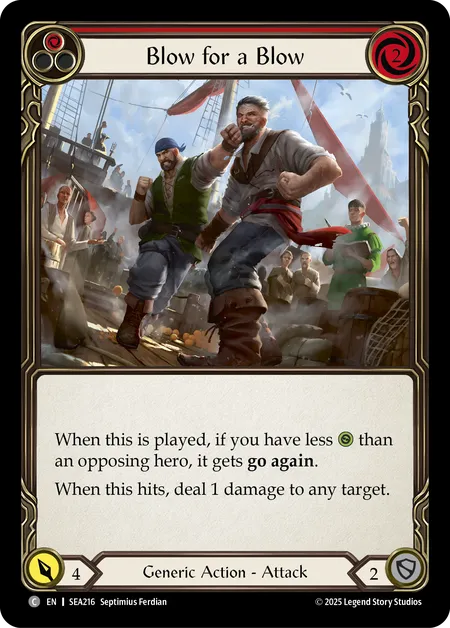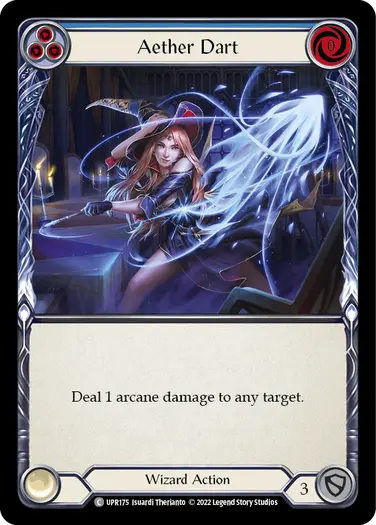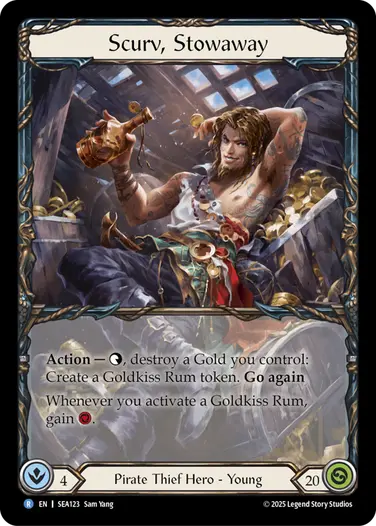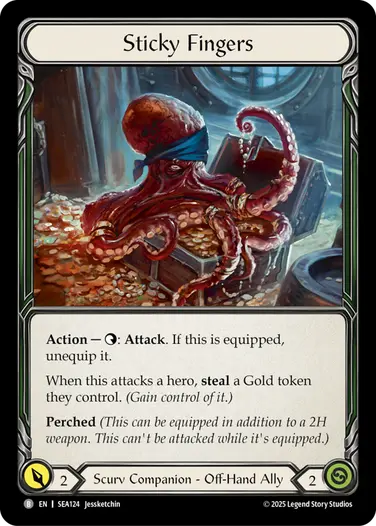A pirate’s life is equal parts thrilling and scary: oceans swelling, storms raging, sea monsters waiting, and adventures calling. Who knows what lurks in the vast unknown of Rathe’s open waters, but the Rules Team is back to help you chart a course towards infamy and fortune during High Seas World Premiere weekend in Taipei and at Pre-Release events near you! Niccolo Paqueo and Joshua Scott invite you to set sail with them, showing you all the new rules mapped out to help you find your wins and perhaps ancient treasure in your journeys ahead.
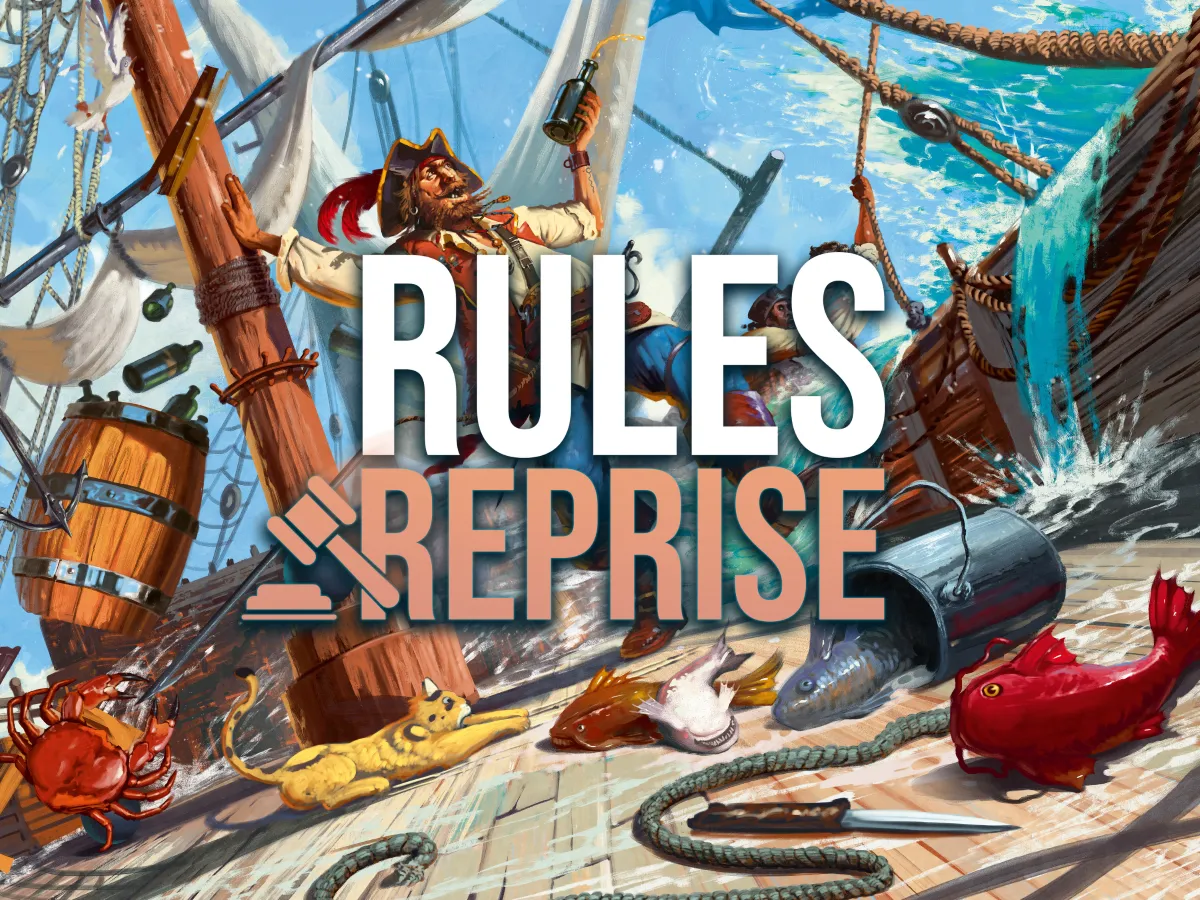
How does Tapping and Untapping work?
High Seas features tapping and untapping as a new mechanic that players will see more often moving forward. Here is the general gist of how it works:
- When a player taps a card, it is rotated 90 degrees, and is considered tapped.
- When a player untaps a card, it is rotated back to its original orientation and is considered untapped again.
- A card begins untapped when it is put or enters into the arena and becomes a permanent.
- You can only tap/untap permanents in the arena.
- There is no “summoning sickness” in Flesh and Blood. If the card has an ability that taps itself as a cost, you can activate that ability the same turn you played it (provided you can pay its costs).
Untapping during the end phase
The end phase of a turn is being updated to add a step where the turn-player untaps their permanents. APUD is a handy acronym to help you remember what happens during the end phase your turn:
- A - Arsenal - Place a card from your hand into an empty arsenal zone if you want.
- P - Pitch - Put cards in your pitch zone on the bottom of your deck.
- U - Untap - Untap all tapped permanents you control.
- D - Draw - Draw up to your hero’s intellect value.
It's important to note, if it's not the end of your turn, you don't untap your permanents - even if it's the first turn of the game.
On the first turn of the game, Tyler plays Kelpie, Tangled Mess. Tyler activates its second ability by paying one resource and tapping Kelpie to target Nic’s Gravy Bones. The activated ability resolves and Nic’s Gravy Bones is tapped. During the end phase of this first turn, Tyler arsenals a card from hand, puts pitched cards on the bottom of the deck, untaps Kelpie, then draws. Since it's still the first turn of the game, Nic will only put any pitched cards on the bottom of the deck and draw. Nic will not untap Gravy Bones as they are not the turn player.
Tapping and Untapping as part of costs and effects
High Seas features many cards that require you to tap an object as part of the cost of activating them. If a cost requires you to tap to activate its ability, but it doesn’t specify the object to tap, you will tap the card that ability is on. You will see this on many of the allies and weapons to simply attack with them.
When a card’s cost or effect instructs you to tap or untap certain objects, only permanents in the arena are eligible to be tapped/untapped. This can include heroes, allies, items, or even defending permanents on the combat chain. In contrast, non-permanent cards, such as attack action cards or defense reactions/blocks on the combat chain, cannot be tapped/untapped.
When paying the cost to play cards/activate abilities, you cannot tap an already tapped object to pay for costs.
In contrast, when resolving an effect that requires you to tap objects when the effect resolves, you are allowed to select an already tapped object; however, that tap effect will fail and will not satisfy any condition nor trigger any effects that look at whether you’ve tapped an object. This is true for untapping as well.
Tyler controls two untapped Golden Cogs and hits Nic with a Cogwerx Dovetail. When Cogwerx Dovetail’s triggered effect resolves, Tyler must untap all cogs they control; however, since both Golden Cogs they control are already untapped, the untap effect will fail.
This is particularly important for optional effects. As a reminder, you cannot choose to do an optional effect if the effect would fail given the current game state.
In a similar scenario to above, Tyler controls one untapped Copper Cog and attacks Nic with a Sky Skimmer. During the damage step, Tyler activates Sky Skimmer’s ability, tapping their Copper Cog as part of its activation cost. When it resolves, Tyler decides for it to get go again. Next, Tyler attacks with Jolly Bludger which triggers when it resolves and becomes an attacking card on the combat chain. When Jolly Bludger’s triggered effect resolves, Nic cannot choose to do the optional effect to tap the already tapped Copper Cog. Choosing to do an optional effect requires that optional effect to be successful given the current game state, and because the cog is already tapped, the tap effect will fail and Jolly Bludger will not get overpower.
Treasure Island
High Seas also features Flesh and Blood’s latest macro: Treasure Island. Similar to its predecessor Sanctuary of Aria from Rosetta, Treasure Island is for exclusive use in High Seas limited formats (i.e. Booster Draft, Sealed Deck, etc.), giving players an added level of dimension and interaction to their games.
When you begin a game in one of these High Seas limited formats, one Treasure Island is placed between both players into the arena before you reveal your heroes. Both players will interact with it in two ways.
- Treasure Island’s first ability triggers the first time a hero is attacked each turn. Players will put a gold token on this when the triggered effect resolves.
- Treasure Island’s second ability triggers each time you or an ally you control deals damage to an opposing hero. When this triggered effect resolves. you must remove gold counters from Treasure Island equal to the amount of damage dealt, then you will create Gold tokens equal to the number of counters removed this way.
Important to note is that as there is only ONE Treasure Island in the game, neither player owns or controls Treasure Island for the purposes of rules and effects. As it is a shared object: all players in the game are responsible for ensuring that Treasure Island triggers are generated and resolved appropriately.
You can expect that if you triggered any of Treasure Island’s abilities, you will be the player who adds it to the stack. This is important as you may have multiple triggered effects to add to the stack, including Treasure Island’s effect. In this case, you will be responsible for adding it to the stack as if you are that triggered effect’s controller and you will determine its order among your other triggered effects being added.
Lastly, Treasure Island follows many of the same rules its Sanctuary of Aria predecessor does. Macros are neither cards nor tokens so you cannot choose Treasure Island for effects that allow you to choose or target cards/tokens. Moreover, you cannot name Treasure Island for effects that require you to name a card.
As their first action of the turn, Tyler attacks with Expedition to Horizon’s Mantle. This causes the “when this attacks” triggered ability on the card to trigger and will also trigger Treasure Island. Because Tyler is the one who triggered Treasure Island, they are responsible for adding that triggered effect and Expedition to Horizon’s Mantle’s triggered effect to the stack in the order of their choosing.
Face-Down Cards and Watery Grave
Watery Grave is a new ability keyword that is particularly prevalent on some allies and items in the High Seas card-pool.
This ability is active as long as the card with Watery Grave is a permanent in the arena and it triggers when the card is put from the arena into the graveyard (e.g. the card dies or is destroyed). Notably, Watery Grave will not trigger on defending non-permanent cards on the combat chain that are sent to the graveyard as the ability itself is not active.
High Seas also introduces many effects that fill your graveyard. It is important to note that these effects such as discarding a card from your hand, destroying the top card of your deck, putting a card into the graveyard from your deck, etc. do not trigger Watery Grave.
When Watery Grave’s triggered effect resolves, you must turn that card with Watery Grave face-down in your graveyard. Similar to face-down cards in the banished zone, you can look at face-down cards in your graveyard but your opponents cannot.
On some cards, you will see the keyword Legend of the Watery Grave. This is a thematic representation of the two ability keywords “Legendary” and “Watery Grave.” A card with Legend of the Watery Grave functions in the same ways as their keywords: You may only have 1 copy of that card in your constructed deck, and the same rules related to Watery Grave apply.
Lastly, cards and effects that interact with cards in the graveyard cannot interact with face-down cards in the graveyard unless the effect specifies that it affects face-down cards.
Tyler, playing as Gravy Bones, has a Diamond Amulet in the arena. Tyler activates Diamond Amulet’s ability and it is added to the stack first. As Diamond Amulet is destroyed to pay the activation cost, its Legend of the Watery Grave ability triggers and is added to the stack second. Tyler resolves the triggered effect, turning Diamond Amulet face-down in the graveyard, then will gain an action point from Diamond Amulet’s activated ability. As Diamond Amulet is a blue card and was put into their graveyard this turn, Gravy Bones may now play any face-up cards with Watery Grave from their graveyard for the remainder of their turn; however, they are unable to play the Diamond Amulet as it is now face-down.
Give (Control) and Steal
Effects that allow you to steal or give control of objects make an appearance in the High Seas card-pool. Here’s a summary to get you started on the fun lootin’ life of a pirate:
- When a player is instructed to steal something from another player, they choose what to steal and they gain control of it.
- When a player is instructed to give something to another player, they choose what to give, and the other player gains control of it.
- Any objects given or stolen will remain in its current state (e.g. tapped/untapped, existing counters, etc.).
- If the object being stolen or being given is currently equipped, the recipient must be able to equip that object, else the effect will fail. If they can, then it will be equipped and can cause effects to trigger.
- Giving control of an object does not count as the other hero stealing that object for the purposes of rules or effects.
Go Fish
Go Fish is a label-keyword debuting in High Seas that appears on some attack action cards with "harpoon" in their names. Whenever an attack with Go Fish hits a hero, that hero chooses and reveals a card from their hand. Depending on what card is revealed by the opponent will determine if any additional effects occur.
Some of the cards with "harpoon" in their names in High Seas have an additional effect when the Go Fish triggered effect resolves that is conditioned on you having activated a cannon this turn. If you want to take advantage of this additional effect, make sure you do so before you begin resolving the Go Fish triggered effect!
Tyler resolves Hammerhead, Harpoon Cannon then hits Nic with a King Shark Harpoon, triggering its Go Fish ability. As Tyler has activated a cannon this turn, Tyler looks at Nic’s hand when the triggered effect resolves. Tyler chooses a Goldfin Harpoon in Nic’s hand and Nic reveals it. Because it is an attack action card, Nic discards it, which causes it to be removed from the game, and Tyler will create a Gold token.
High Tide
High Tide is also a new label-keyword just like Go Fish. High Tide abilities generate continuous effects that are constantly checking if there are 2 or more blue cards in your pitch zone. If you do, you get their specified effect. Note that unless otherwise stated, High Tide abilities are not functional and therefore not active on cards while they are defending.
Companions and Perched
Companions are a new type of card that represents a hero’s faithful partner in their adventures on the open ocean. In High Seas, a companion card will have the companion type printed in its type preceded by the name of a hero. That hero has exclusive use of that companion card and may add it to their card-pool.
Companions in High Seas are also allies: they have a life property on the bottom right hand corner of their cards and can be attacked like all other allies. However, exercise caution if that companion is perched.
Perched is a keyword featured on companions like Polly Cranka. Companions with perched allow you to equip that companion in addition to equipping a two-handed weapon. While that companion ally with perched is equipped, they cannot be the target of any attacks; however, they can still be targeted/chosen or damaged by effects.
In a Blitz game, Nic is playing as Puffin and equips Spitfire along with Polly Cranka during the start of game procedure. Tyler attacks Nic with Blow for a Blow, as they are unable to declare the equipped Polly Cranka as the attack target. Blow for a Blow hits Puffin, triggering its ability. In the damage step, Tyler adds the triggered effect to the stack, targeting Polly Cranka. When it resolves, it deals 1 damage to Polly Cranka and destroys it.
In a Blitz game, Nic is playing as Puffin and equips Spitfire along with Polly Cranka during the start of game procedure. During the first turn of the game, Tyler plays Aether Dart (blue), targeting the equipped Polly Cranka. When it resolves, it deals 1 arcane damage to Polly Cranka and destroys it.
A fashionably late introduction to Scurv
As you may have seen during the High Seas World Premiere, some players opened a fourth hero. Let’s break down Flesh and Blood’s first ever Pirate Thief—Scurv, Stowaway.
How can I play Scurv in a High Seas limited format?
Scurv is a hero that randomly appears inside of High Seas booster packs (at "Rare" rarity) in place of one of the draftable cards. Scurv will have a Flesh and Blood logo card-back and is not a Basic card. Scurv will not appear in the Expansion Slot.
In order to play Scurv in a High Seas limited format, one of the following must be true:
- If you are playing Sealed Deck format, you must open Scurv in your sealed card-pool.
- If you are playing Booster Draft format, you must draft Scurv into your card-pool. Scurv is not double-sided: if you pick him, you do not reveal him to your pod.
If you have Scurv in your card-pool, you are not obligated to play as Scurv and you can still play as one of the other available heroes in High Seas.
If you are playing at an event that requires you to fill out a card-pool registration sheet and you have Scurv in your card-pool, you will mark down how many copies of it you have in your card-pool (as you do with every other card in your card-pool).
Wanted: Sticky Fingers
Scurv does not have a Basic weapon to start the game equipped with. Instead, there is a companion ally that is exclusive to Scurv named Sticky Fingers that he can start the game equipped with.
Sticky Fingers is an off-hand companion that is a Basic rarity card. You do not need to open a copy of Sticky Fingers in your packs to be able to use it with the Scurv you have in your card-pool.
Sticky Fingers begins the game perched and can attack using its first activated ability. It also has a triggered-static ability that triggers when you attack a hero. When this triggered effect resolves, you will steal a Gold token that hero controls.
What else can I have in a Scurv deck?
In addition to being able to use Sticky Fingers, Scurv has a very limited card-pool consisting of cards with just the Pirate supertype, and generic cards. Notably, some Pirate cards check to see if your hero is a Thief, resulting in additional effects that non-Thief heroes won’t be able to take advantage of. If you are Scurv you might want to capitalise on these.
Can I play Scurv in a constructed format?
As Scurv, Stowaway has the “young” sub-type, you can play him in constructed formats that allow young heroes, such as Blitz or Commoner. If the format doesn’t allow young heroes, such as Classic Constructed or Living Legend, you cannot.
Please note, Treasure Island is only available in games within High Seas limited formats. Even though some Pirate cards with “If you are a Thief” effects interact with Treasure Island, you still cannot use the macro in a constructed game.
